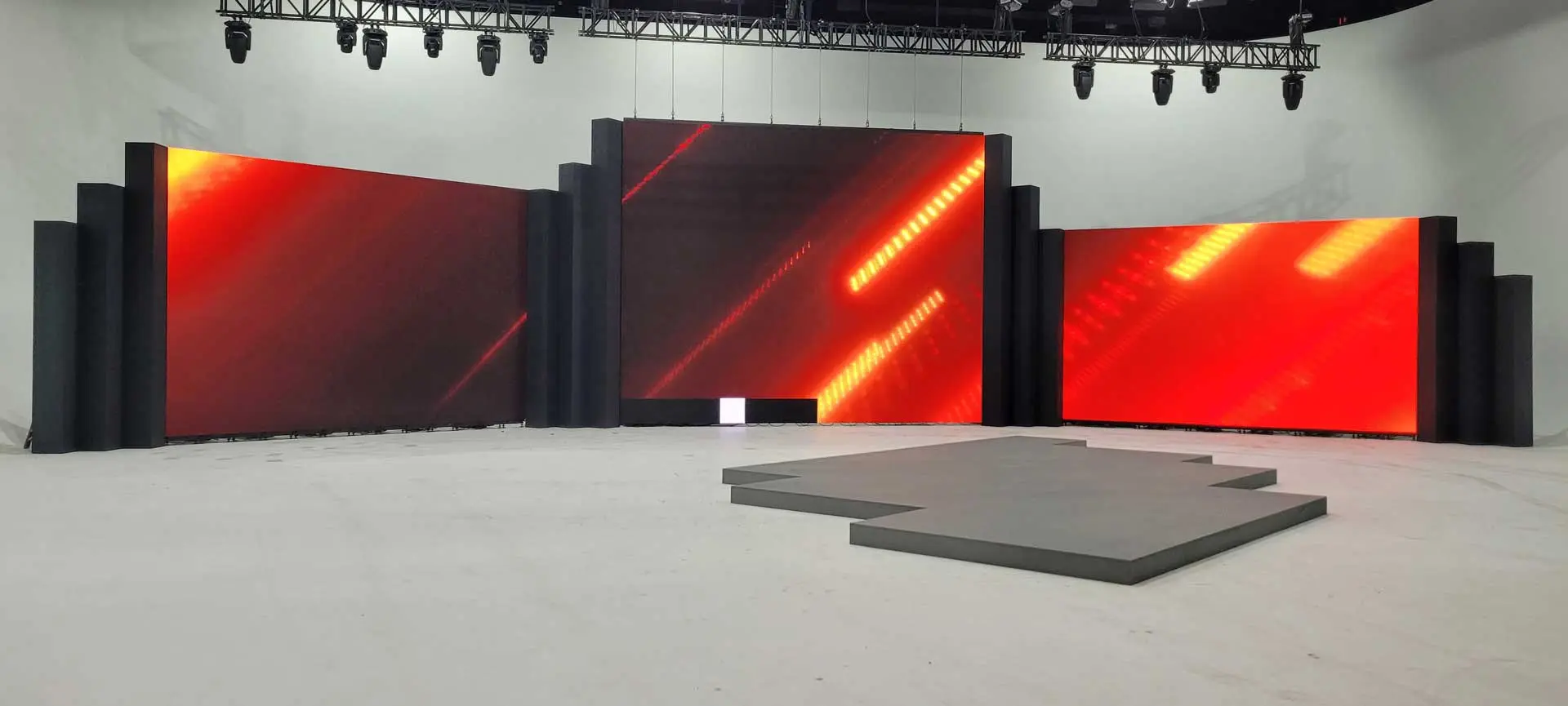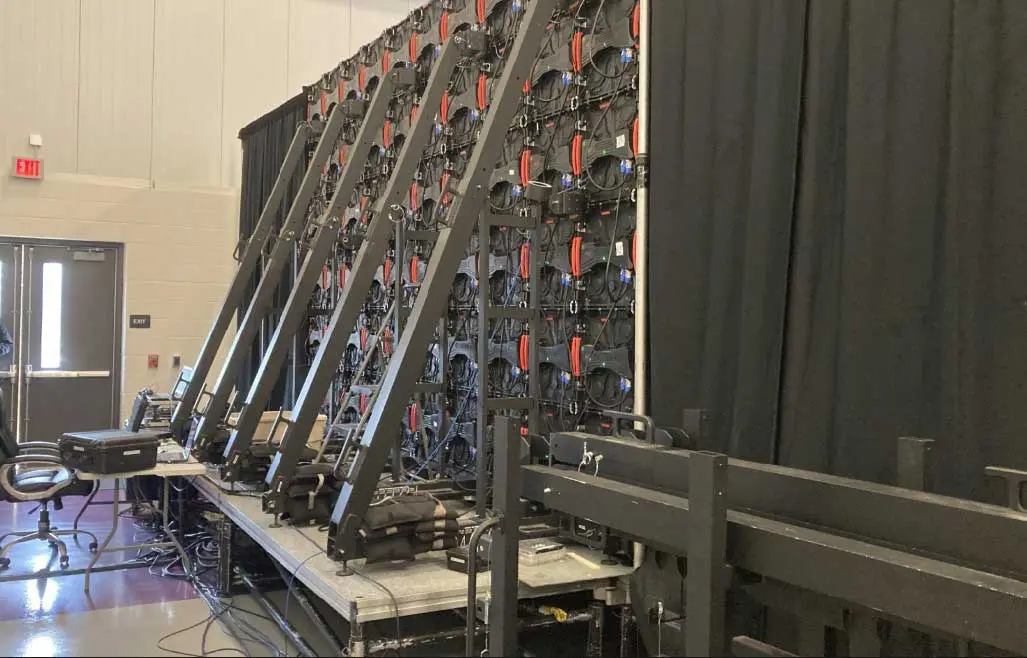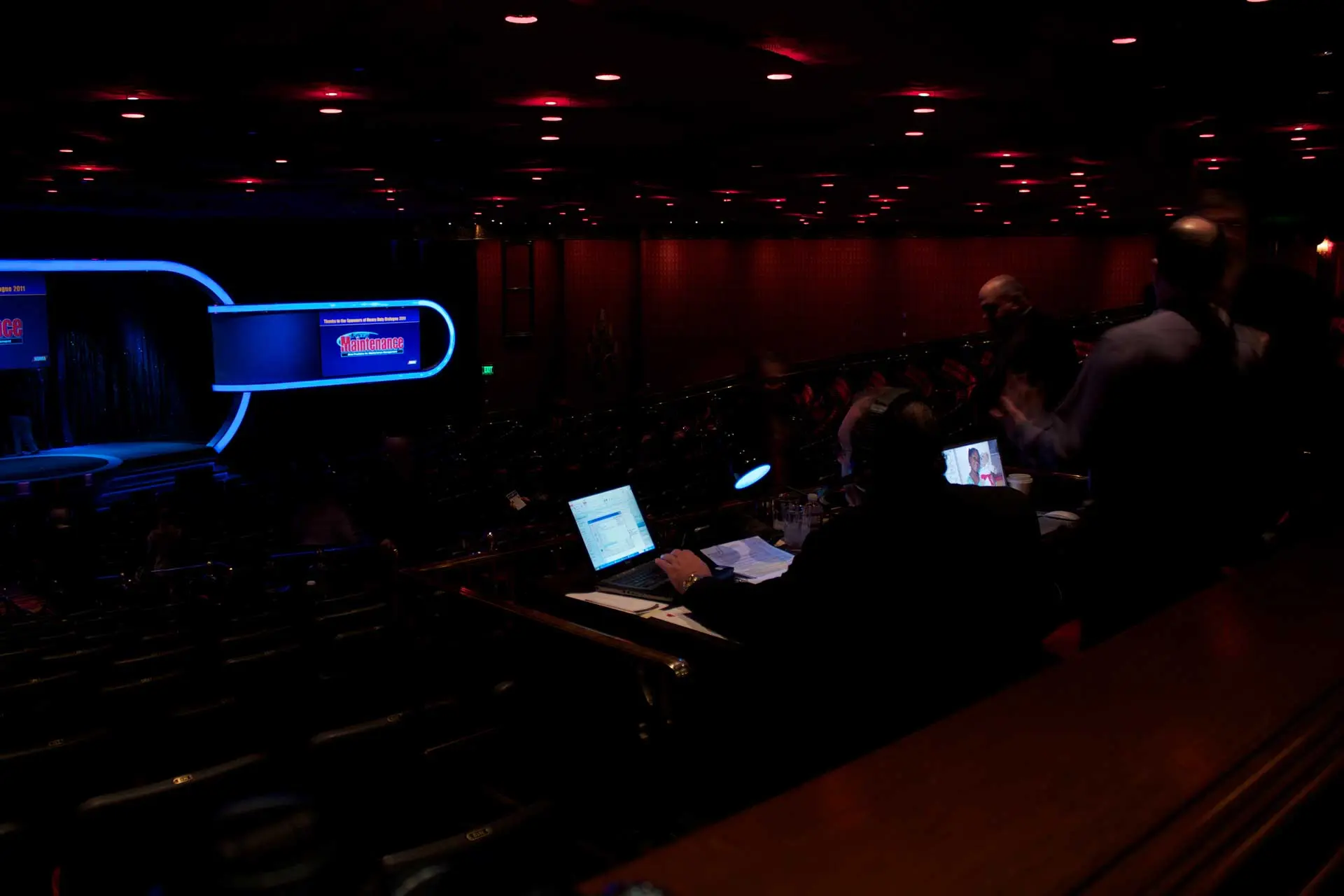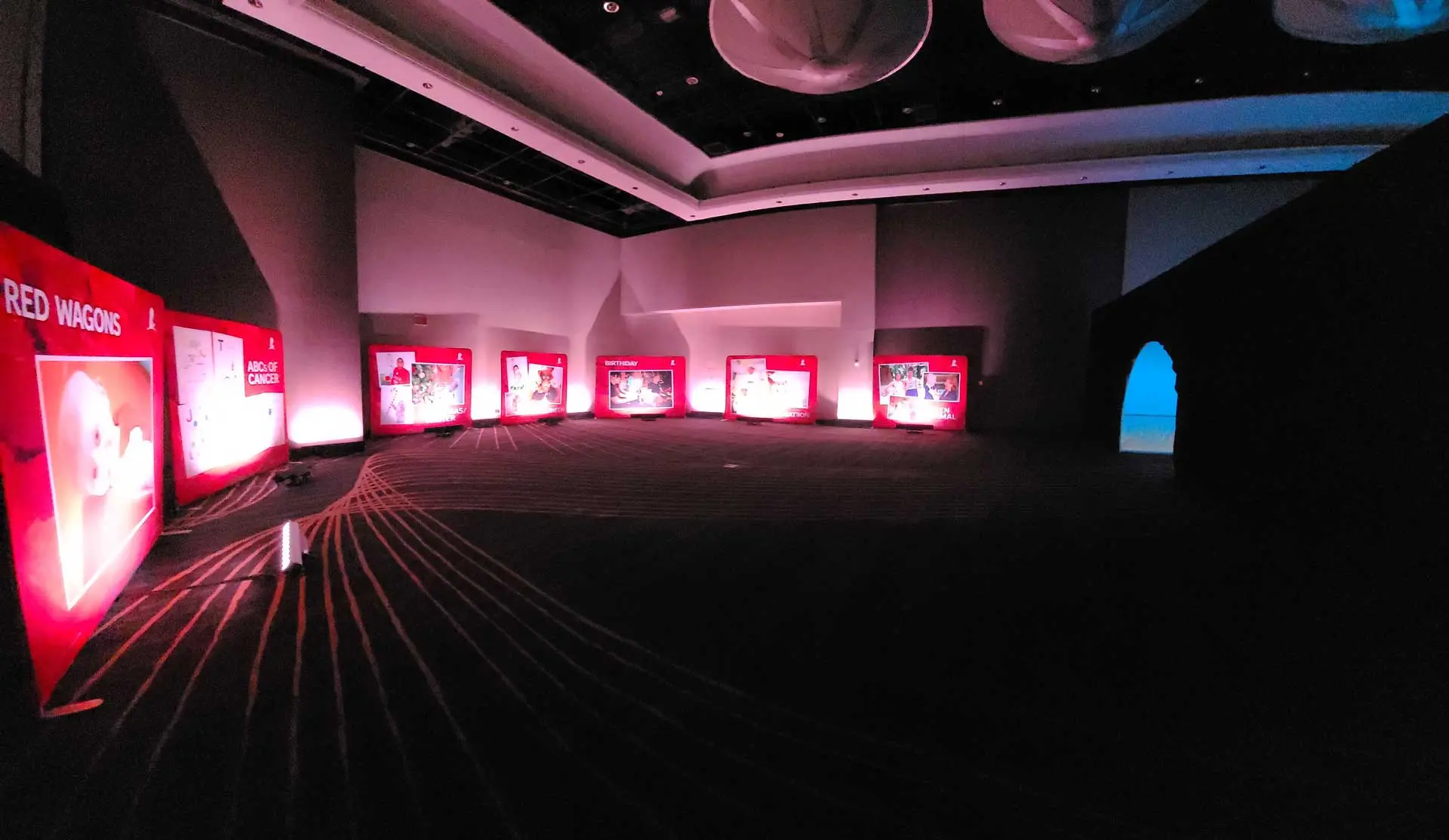Ultimate Guide to Video Wall Systems & Tech
In this comprehensive guide, we will explore the exciting world of video wall systems and technology. From the basics of video wall technology to advanced solutions for impressive digital displays, we will provide expert insights and valuable information to help you make informed decisions. Whether you’re a business owner, event organizer, or technology enthusiast, this guide will equip you with the knowledge you need to understand video wall systems and their potential applications. Let’s dive in!
Imagine walking into a bustling conference room, filled with anticipation and excitement. As you take your seat, your eyes are irresistibly drawn to a massive digital display covering an entire wall. The vibrant colors, sharp imagery, and seamless visual storytelling capture your attention, leaving you captivated and immersed in the experience.
This is the power of video wall systems. They have the ability to transform any space into a dynamic visual masterpiece, captivating audiences and conveying powerful messages. From corporate boardrooms and trade show booths to retail stores and control centers, video walls have become a ubiquitous presence in the world of digital displays.
However, behind the mesmerizing screens lies a complex web of technology and expertise. To truly appreciate and harness the full potential of video wall systems, one must understand the intricacies of their design, components, and applications.

Key Takeaways:
- Video wall systems offer a captivating visual experience with vibrant colors and seamless imagery.
- Understanding the technology and components behind video walls is crucial for optimizing their performance.
- Video walls have diverse applications in various industries, ranging from corporate settings to retail environments.
- On Site Specialist is a trusted provider of video wall solutions, offering expert insights and personalized assistance.
- Stay tuned for the rest of this guide to uncover the ins and outs of video wall systems and technology.
Introduction to Video Wall Systems
In this section, we will provide an introduction to video wall systems. A video wall is a display technology that consists of multiple screens tiled together to create a larger visual canvas. Unlike traditional displays, video walls offer a seamless and immersive viewing experience, capturing viewers’ attention with their sheer size and impact.
Video wall technology has come a long way since its inception. Earlier video walls were assembled using individual monitors connected through complex cabling systems. However, with advancements in technology, video walls have evolved into sophisticated systems that seamlessly integrate multiple display panels, delivering stunning visual imagery.
Defining a Video Wall
A video wall is a large display made up of multiple individual panels or screens, arranged in an ordered grid-like pattern. These screens can be LCD, LED, or OLED panels, depending on the specific requirements of the installation.
Video walls are designed to create a single visual canvas, where content can be displayed across the entire wall or segmented into different sections. They offer a highly scalable solution, allowing users to expand the display area by adding more panels as needed.
The Evolution of Video Wall Technology
The evolution of video wall technology can be traced back to the early days of basic monitors. In the beginning, video walls were limited to using multiple CRT (cathode ray tube) monitors, which had significant bezel sizes and resolution limitations.
As technology advanced, CRT monitors were replaced by thinner and more versatile LCD (liquid crystal display) screens. This shift allowed for smaller bezel sizes, creating a more seamless visual experience.
Today, video walls leverage LED (light-emitting diode) technology, enabling even thinner bezels and higher resolution displays. LED video walls offer vibrant colors, enhanced brightness levels, and improved contrast ratios, resulting in stunning visual presentations.
With the advent of advanced video wall processors and software, video walls now have the capability to display multiple sources simultaneously, enable content management and scheduling, and provide real-time data integration for dynamic content.
In summary, the evolution of video wall technology has transformed traditional displays into impressive visual canvases, revolutionizing the way businesses and organizations communicate and engage with their audiences.
Video Wall Components and Technology
In this section, we will delve into the components and technology behind video wall systems.
Key Components of a Video Wall System
A video wall system is comprised of several key components that work together to deliver stunning visual displays. These components include:
- Display Panels: The video wall is made up of multiple display panels or screens.
- Video Processors: These devices process and distribute video signals to the display panels.
- Video Wall Controllers: The controllers manage the content and configuration of the video wall.
- Mounting Systems: The mounting systems securely hold the display panels in place.
Each of these components plays a vital role in creating a seamless and immersive video wall experience.
How Video Wall Technology Works
Video wall technology combines hardware and software to create a synchronized and impactful visual display. Here’s a breakdown of how video wall technology works:
- Video Inputs: The video wall receives inputs from various sources such as computers, media players, or cameras.
- Signal Processing: The video signals are processed by the video processor, which optimizes them for display on the video wall.
- Display Synchronization: The video wall controller ensures that the content is synchronized across all the display panels, creating a seamless visual experience.
By understanding how video wall technology works, you can appreciate the intricate and advanced systems that power these impressive displays.
Different Types of Video Walls
The world of video walls offers a diverse range of options to suit different needs and preferences. In this section, we will explore the different types of video walls available in the market, including various panel technologies, display configurations, and specific applications. Whether you’re looking for a traditional tiled display or an innovative curved or transparent screen, there is a video wall to meet your requirements.
One of the most common types of video wall displays is the tiled display, where multiple panels are arranged in a grid-like formation to create a large, seamless screen. This type of video wall is often used in control rooms, command centers, and retail environments, where a continuous and immersive viewing experience is desired.
Another type of video wall gaining popularity is the curved display. With advancements in technology, video walls can now be curved to create a more immersive and engaging visual experience. Curved video walls are often used in immersive installations, museums, and simulation centers, where realism and impact are of utmost importance.
For businesses and organizations looking to make a bold statement, transparent video walls provide a unique and futuristic display solution. These transparent screens allow viewers to see through the display while still maintaining vibrant visuals. Transparent video walls are commonly used in retail stores, museums, and showrooms, where products or artifacts can be showcased while providing contextual information.

As technology continues to advance, video wall solutions are becoming more versatile and customizable. Whether you need a traditional tiled display, a curved screen, or a transparent showcase, there is a video wall technology that can bring your vision to life. Stay tuned as we explore further in our ultimate guide to video wall systems and technology.
Selecting the Right Video Wall for Your Needs
Choosing the perfect video wall for your unique requirements can feel like a daunting task. With a wide range of options available, it’s crucial to consider several factors that will ensure the best fit for your needs. Here, we will provide valuable insights into the key factors to consider when selecting a video wall. Additionally, we will introduce you to the video wall solutions offered by On Site Specialist, a leading provider of cutting-edge video wall technology.
Factors to Consider When Choosing a Video Wall
- Screen Size: Determine the optimum screen size based on the viewing distance and available space. A larger screen size will create a more immersive experience, while a smaller screen might be suitable for more intimate settings.
- Resolution: Consider the resolution that best suits your content and viewing environment. Higher resolutions offer greater clarity and detail, but they may also require more powerful processing capabilities.
- Brightness: Evaluate the brightness level required for your video wall, depending on the ambient lighting conditions in the installation location. Brighter displays are ideal for well-lit environments, while lower brightness settings are suitable for dimmer spaces.
- Viewing Distance: Take into account the distance at which your audience will be viewing the video wall. This will help determine the pixel pitch required to ensure an optimal viewing experience with no visible pixelation.
- Content Requirements: Consider the type of content you plan to display on your video wall. Certain applications, such as data visualization or high-definition videos, may require specific features or capabilities to deliver the desired results.
Video Wall Solutions by On Site Specialist
At On Site Specialist, we understand the challenges of selecting the right video wall. Our team of experts is dedicated to providing tailored video wall solutions that meet your unique needs. With our extensive range of cutting-edge video wall technology, we offer a diverse selection of display panels, video processors, and video wall controllers to suit various applications.
From seamless tiling to advanced content management systems, our video wall solutions are designed to deliver stunning visual experiences. Whether you require a video wall for a control room, conference center, retail space, or any other setting, our expertise and customer-centric approach ensure that you find the perfect solution to elevate your visual communication.
Partnering with On Site Specialist empowers you to unleash the full potential of video wall technology, creating immersive experiences that captivate audiences and leave a lasting impression. Contact us today to explore our range of video wall solutions and benefit from our industry-leading expertise.
The Video Wall Installation Process
Installing a video wall involves several steps and considerations. In this section, we will guide you through the installation process, covering aspects such as site preparation, mounting options, cabling, and calibration. We will share expert tips and best practices to ensure a seamless and successful installation. Whether you’re setting up a video wall for a conference room, control center, or public space, this section will provide you with the information you need to execute a professional installation.
Before starting the installation, it is crucial to prepare the site properly. This involves assessing the available space, measuring dimensions, and ensuring sufficient power supply in the vicinity. Adequate ventilation is also essential to prevent overheating of the display panels. By carefully evaluating the site conditions, you can optimize the performance and longevity of your video wall.
Next, selecting the appropriate mounting option is crucial for the stability and aesthetics of the installation. Wall mounting, floor mounting, and ceiling suspension are common options, each with its advantages depending on the space and requirements. It is important to ensure that the mounting solution provides adequate support, allowing for easy maintenance and accessibility if needed.
Cabling is another critical aspect of the installation process. Proper cable management ensures a clean and organized setup while minimizing the risk of signal degradation or interference. Working with high-quality cables and connectors is recommended to maintain optimal video quality and signal integrity.
Once the physical installation is complete, calibration plays a vital role in achieving optimal display performance. This involves adjusting the brightness, contrast, color accuracy, and alignment of the video wall panels. Calibration is typically performed using specialized software or hardware tools to ensure consistent visual quality across all panels.
Throughout the installation process, it is advisable to follow manufacturer guidelines and specifications. Additionally, seeking the assistance of professional installation services, such as On Site Specialist, can streamline the process and ensure a flawless result. Their expertise and experience with video wall technology can provide valuable insights and save time and effort.
By following these guidelines and relying on expert advice, you can achieve a professional video wall installation that meets your specific needs and elevates your visual communication.
Programming and Controlling Your Video Wall
Video Wall Controllers: An Overview
Once your video wall is installed, effective programming and control are essential to maximize its impact. In this section, we will explore the role of video wall controllers in managing and displaying content across multiple screens.
A video wall controller acts as the central hub that enables seamless coordination between the various display panels in your video wall. It allows you to control and manage the visual content, ensuring a synchronized and captivating viewing experience.
Video wall controllers come with a range of features and functionalities designed to streamline the programming and control process. Some common features include:
- Multi-screen management: Video wall controllers allow you to divide screens into multiple zones, enabling you to display different content simultaneously.
- Content scheduling: You can pre-program the display of specific content at designated times, making it easier to manage and automate the content rotation.
- Real-time updates: Video wall controllers support real-time updates, enabling you to display live data feeds, social media updates, news, and other dynamic information.
- Remote control: Many video wall controllers offer remote access and control, allowing you to manage and update the system from a central location.
With the right video wall controller, you can unleash the full potential of your video wall, creating engaging and immersive visual experiences for your audience.
Video Wall Processors: The Engine Behind the Display
In addition to video wall controllers, video wall processors play a crucial role in the programming and control of your video wall. Considered the “engine” behind the display, video wall processors handle the processing and distribution of content across the multiple screens.
Video wall processors are responsible for tasks such as:
- Signal processing: They process video signals from various sources and ensure optimal compatibility with the display panels.
- Video scaling: Video wall processors automatically adjust the resolution and aspect ratio of the content to match the screens’ specifications.
- Content distribution: They distribute the processed video signals to the respective display panels, maintaining seamless synchronization and timing.
- Video wall configuration: Video wall processors enable you to customize the layout and arrangement of the screens, creating visually appealing configurations.
By working in conjunction with video wall controllers, video wall processors ensure smooth and uninterrupted content playback across the entire video wall.
When selecting video wall controllers and processors, it’s crucial to consider factors such as scalability, compatibility, ease of use, and future-proofing. Working with experts like On Site Specialist can help you navigate through the available options and choose the most suitable solution for your video wall programming and control needs.

Innovative Uses and Applications for Video Walls
Video walls have revolutionized the way businesses and organizations communicate with their audiences. The versatility and impact of video walls have expanded beyond traditional uses, leading to innovative applications across various industries. In this section, we will explore some of the most exciting and impactful uses of video walls, focusing on elevating customer experience and enhancing public information and safety.
Elevating Customer Experience with Digital Signage
Digital signage solutions powered by video walls have transformed the retail industry, creating immersive and interactive experiences for customers. With video walls, businesses can captivate their audience by displaying dynamic and engaging content, ranging from visually stunning advertisements to educational product showcases. By leveraging the power of video walls, retailers can elevate their customer experience and leave a lasting impression.
Moreover, video walls have found applications in various sectors beyond retail. In entertainment venues, such as stadiums and theaters, video walls enhance the overall atmosphere and engage audiences with vibrant visuals and real-time updates. Museums and galleries utilize video walls to bring art to life and create memorable exhibitions. The possibilities are endless, as video walls can be customized to fit the unique needs and branding of each establishment.
Enhancing Public Information and Safety
Video walls play a crucial role in public information and safety by providing real-time displays of critical data. In control rooms and command centers, video walls allow operators to monitor multiple information sources simultaneously, improving situational awareness and response times. By consolidating data from various sensors and monitoring systems onto a large-scale display, video walls enable faster decision-making and efficient crisis management.
In transportation hubs, video walls serve as essential communication tools, displaying up-to-date travel information, schedules, and emergency announcements. Passengers can easily access important details and navigate through the facility with confidence. Additionally, video walls in public spaces can be used to deliver safety messages, emergency instructions, and public service announcements, ensuring the well-being of individuals and communities.
The continued advancements in video wall technology have made it possible to deliver impactful communication through visually stunning displays. With the ability to seamlessly integrate with existing infrastructure and software, video walls offer unmatched flexibility and scalability to meet the evolving needs of businesses and organizations.
Trends in Video Wall Technology
As technology continues to advance at an unprecedented pace, video wall technology is no exception. The latest advancements in display technologies and content management solutions are shaping the future of video walls. Staying up to date with these trends is crucial to harnessing the full potential of video wall technology for your specific needs.
One of the key trends in video wall technology is the development of increasingly high-resolution displays. As visual clarity becomes paramount, advancements in display technologies have led to the creation of video walls with stunning image quality. These high-resolution displays offer enhanced detail, vibrant colors, and exceptional brightness, ensuring an immersive viewing experience for businesses and organizations.
Another noteworthy trend is the integration of innovative content management solutions. With the growing need for dynamic and engaging content, video wall technology has evolved to provide effective methods of controlling and distributing content across multiple screens. Content management systems now offer intuitive interfaces, allowing users to effortlessly schedule, update, and manage content on their video walls. This flexibility enables businesses to deliver targeted, real-time information to their audiences, keeping them informed and engaged.
Furthermore, video wall technology is becoming increasingly versatile, with the ability to integrate with various other technologies. From interactive touch capabilities to augmented reality, video walls are expanding their functionality beyond traditional displays. This opens up new possibilities for engaging audiences and creating immersive experiences across industries such as retail, entertainment, and education.
“Video wall technology is evolving at a rapid pace, empowering businesses to captivate their audiences like never before. The latest advancements in display technologies and content management solutions are revolutionizing the way we communicate and deliver information.”
Looking ahead, the future of video walls holds even more promise. We can anticipate further advancements in display technologies, with the development of ultra-thin and flexible screens that can seamlessly blend into any environment. Additionally, advancements in content creation tools and artificial intelligence will enable businesses to personalize and optimize their video wall content, delivering personalized experiences to every viewer.
As these trends continue to shape the video wall industry, it’s essential to partner with a trusted expert who can guide you through the latest advancements and help you leverage the full potential of video wall technology for your specific needs. At On Site Specialist, we stay at the forefront of these trends and offer cutting-edge video wall solutions tailored to your requirements. Contact us today to discover how video wall technology can transform your visual communication.
Conclusion
In this ultimate guide to video wall systems and technology, we have provided a comprehensive overview of this exciting field. From the basics of video wall technology to selecting the right video wall for your needs and exploring innovative applications, we have covered a wide range of topics.
We hope that this guide has equipped you with the knowledge and insights to make informed decisions and unlock the full potential of video wall systems. With the power of video wall technology, you can create stunning digital displays that captivate audiences and elevate your visual communication.
If you have any further questions or need personalized assistance, feel free to reach out to us at On Site Specialist. Our team of experts is ready to help you navigate the world of video walls and find the perfect solution for your specific requirements.
Thank you for joining us on this journey through the realm of video wall systems. Embrace the possibilities, explore the creative potential, and take your visual displays to new heights with video wall technology.
FAQ
What is a video wall?
A video wall is a large display made up of multiple screens arranged in a grid-like pattern. It is used to create an immersive visual experience by seamlessly combining individual displays into one large screen.
How has video wall technology evolved over time?
Video wall technology has evolved significantly from the early days of basic monitors. Today, we have advanced display panels, powerful video wall processors, and sophisticated video wall controllers that enable seamless content management and distribution.
What are the key components of a video wall system?
The key components of a video wall system include display panels, video wall processors, video wall controllers, and mounting systems. These components work together to create a seamless and immersive visual experience.
How does video wall technology work?
Video wall technology works by combining multiple display panels to create a unified visual display. Video inputs are processed and distributed by video wall processors, and the content is controlled and managed through video wall controllers.
What are the different types of video walls available?
There are different types of video walls available, such as traditional tiled displays, curved video walls, and transparent screens. These options cater to various needs and preferences, allowing for flexibility in design and application.
What factors should I consider when choosing a video wall?
When choosing a video wall, it is important to consider factors such as screen size, resolution, brightness, viewing distance, and content requirements. These factors will help determine the most suitable video wall for your specific needs.
What video wall solutions does On Site Specialist offer?
On Site Specialist offers a range of video wall solutions, including cutting-edge technology and expert advice. Their expertise can help you find the perfect video wall system for your specific requirements.
What is involved in the video wall installation process?
The video wall installation process involves site preparation, mounting options, cabling, and calibration. It is important to follow best practices and expert tips to ensure a successful and professional installation.
What are video wall controllers and processors?
Video wall controllers are devices that manage and control the content displayed on a video wall. Video wall processors, on the other hand, process and distribute the video inputs to the individual display panels, ensuring a synchronized and seamless visual experience.
What are some innovative uses and applications for video walls?
Video walls can be used to elevate customer experience through digital signage, create immersive retail experiences, display real-time critical data in control rooms and transportation hubs, and more. The possibilities for impactful communication are endless.
What are the latest trends in video wall technology?
The latest trends in video wall technology include advancements in display technologies, innovative content management solutions, and the integration of artificial intelligence for enhanced interactivity. Staying up to date with these trends will help harness the full potential of video wall technology.









